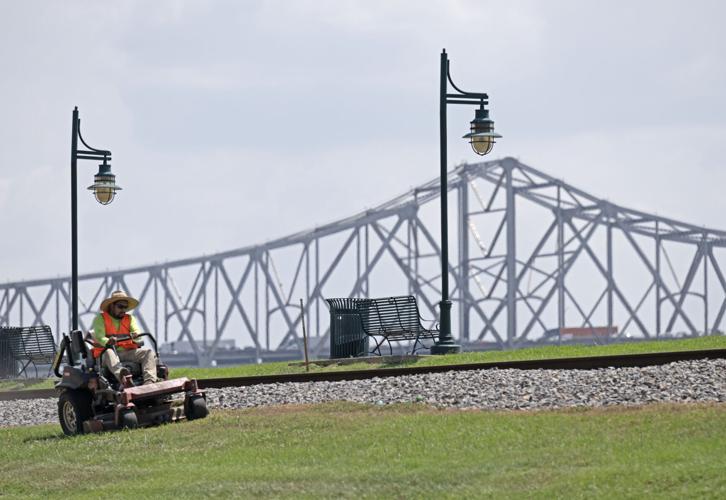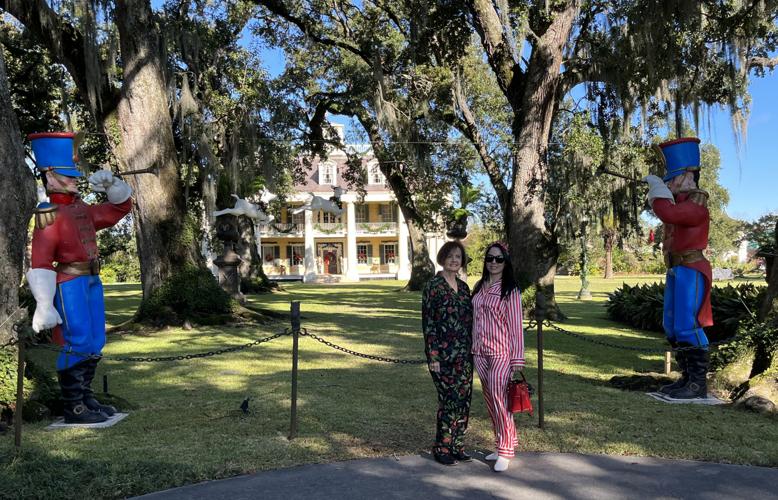Mary Gehman has not only written a book about River Road, she also lives next to the Mississippi in the Ascension Parish town of Donaldsonville.
So who better to answer a reader's question about the roadway's starting and ending points in our state?
Gehman's 2003 book, "Touring Louisiana's Great River Road: The Mississippi from Angola North to Venice South" would seem to answer the query with its subtitle, but there's much more to the story.

File photo of Houmas House. Del Currier, left, and her daughter-in-law, Brenda, pose in front of the holiday backdrop at the Houmas House Estate and Gardens.
"It doesn't start at the beginning where the river hits the state line. You have to make that clear," Gehman said. "Because there simply is no River Road (there)."
The road actually forms south of Angola and across to the western side of the Mississippi around Morganza in Pointe Coupee Parish.
Gehman says the road is not a straight shot, but passes through New Roads and by several old plantations along the river before requiring an inland jaunt.
To be clear, River Road and U.S. Highway 61, sometimes called Great River Road, run along the same path — but they are two different roads. U.S. Highway 61 runs 1,407 miles between New Orleans and the city of Wyoming, Minnesota. The highway, which generally follows the course of the Mississippi River, is called the Great River Road for much of its route.
According to Gehman's book, River Road between New Orleans and Baton Rouge is what gets the most attention because of the handful of famous plantation homes (Houmas House, Oak Alley and Destrehan among them) that are now museums, and the majority of the massive oil refineries and grain elevators along that stretch.
"It also contains the most accessible and uninterrupted, expanse of road. That's the important thing. There are, however, lots of interesting and historic sites both above Baton Rouge and below New Orleans which should not be overlooked," the book states.
Take Port Hudson, about 20 miles northwest of Baton Rouge, for instance. The unincorporated community is most known as the site of a Civil War battle, and is now a state historic site and location of Port Hudson National Cemetery.

On Whitney Plantation, the Big House is one of the best preserved Creole plantation houses standing on the River Road in Wallace.
Near Port Hudson, the road doesn't run directly beside the river, paralleling it instead, according to Gehman.
"The thing about the River Road, it doesn't mean it's always right beside the levee," she said.
Gehman stressed that River Road is not a continuous stretch. It hops to the western side of the Mississippi and back to the east again at several spots — with some of the smaller roads "broken up so badly that nobody considers it a straight road," she said.
A River Road tour guide, Noah Robert, now deceased, led Gehman on weekend adventures to these lesser-known places on the roadway, which curves with the Big Muddy.

File photo: Implements used in the sugar-making process are on display in the Great River Road Museum's sugarcane exhibit.
"I really sort of had my eyes opened as to other things that go on — the Bonne Carre Spillway, for example, and how that's formed, how that operates," she said, adding that Perique tobacco grows along the road in St. James Parish.
And what will we see if we venture River Road south of New Orleans? Here's a sampling:
- The Barataria Preserve on the west bank, where passersby can soak in wetlands habitats
- Myrtle Grove, Empire, Buras — great spots when the fish are biting
- Fort Jackson, a historic masonry fort
The adventurous, who make it that far, then arrive at Venice, "which is the end of the world, literally, they have a sign there," Gehman said with a chuckle. "It's not the Gulf (of Mexico) at that point, because then there's another almost 50 miles of just marshland. … (T)he road pretty much ends at Venice."
But, indeed, there's a lot to explore before you get there.
"Rich in history and culture, leisure travelers have been drawn to the stories, romance and experiences of the Louisiana Great River for decades," the National Scenic Byway Foundation says on its website. "Rural towns, historic sites, plantations, New Orleans’ French Quarter, Louisiana’s State Capitol, Cajun and Creole culture and cooking, jazz, blues, swamp tours and swamp pop, are long-standing motivations for people to travel the Louisiana Great River Road and are expected to drive people here for decades to come."





